Financial Decision Making Report: Evaluation of SKANSKA PLC Finances
VerifiedAdded on 2022/12/30
|10
|3098
|49
Report
AI Summary
This report provides a comprehensive analysis of the financial decision-making processes within SKANSKA PLC. It begins with an introduction to the importance of financial decision-making and its impact on a firm's market value. The report then delves into the roles, functions, and duties related to accounting and finance within the company, using examples to illustrate key concepts. The core of the report involves a detailed evaluation of SKANSKA PLC's financial figures, including calculations and interpretations of Return on Capital Employed (ROCE), Net Profit Margin, Current Ratio, and Debtor's Collection Period for the years 2018 and 2019. The analysis highlights the company's performance in these areas, identifying strengths and weaknesses, and offering insights into potential causes for observed trends, such as changes in sales, capital employed, and liabilities. The report concludes with a summary of the key findings and their implications for SKANSKA PLC's financial health and future strategies.

Financial decision
making
making
Paraphrase This Document
Need a fresh take? Get an instant paraphrase of this document with our AI Paraphraser
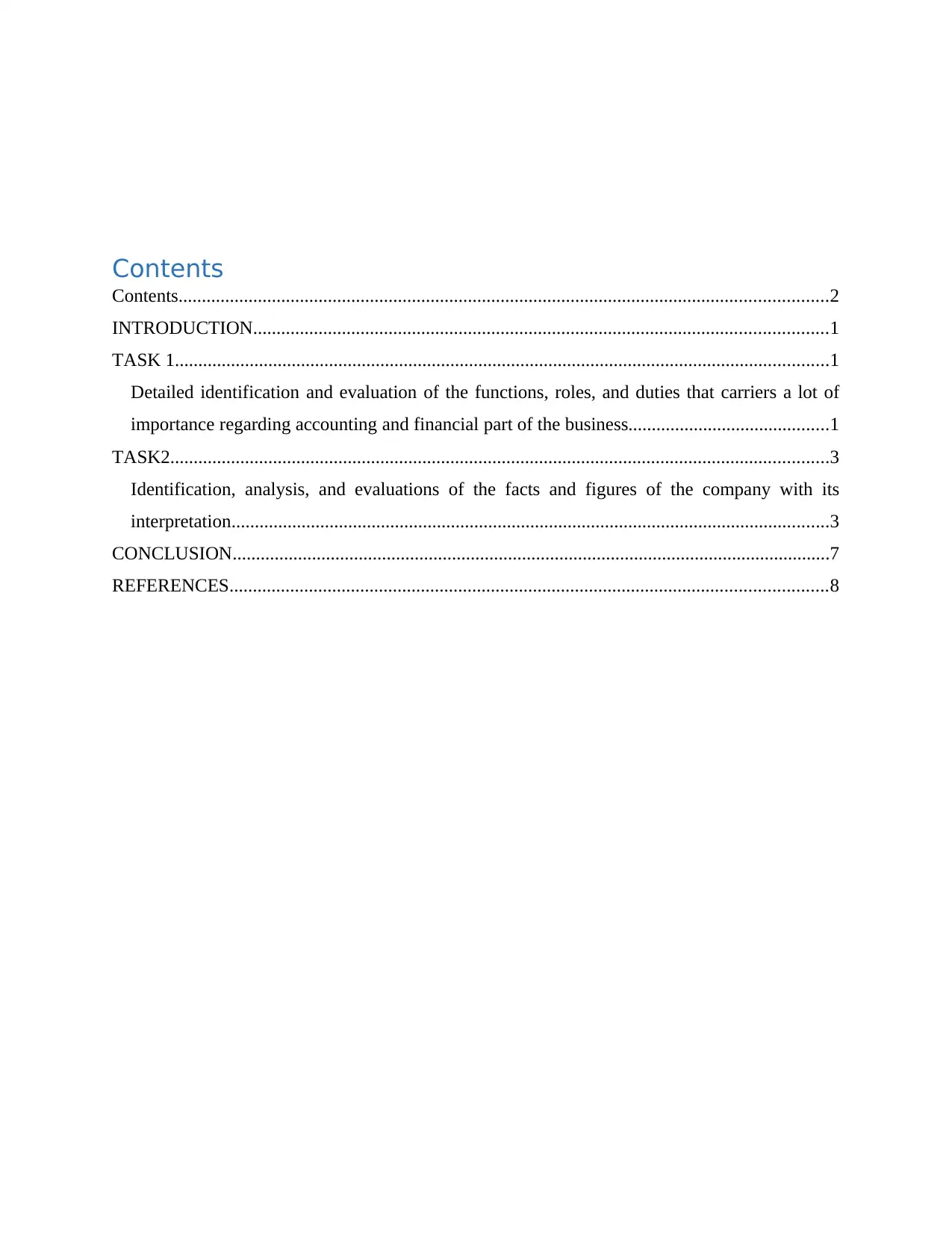
Contents
Contents...........................................................................................................................................2
INTRODUCTION...........................................................................................................................1
TASK 1............................................................................................................................................1
Detailed identification and evaluation of the functions, roles, and duties that carriers a lot of
importance regarding accounting and financial part of the business...........................................1
TASK2.............................................................................................................................................3
Identification, analysis, and evaluations of the facts and figures of the company with its
interpretation................................................................................................................................3
CONCLUSION................................................................................................................................7
REFERENCES................................................................................................................................8
Contents...........................................................................................................................................2
INTRODUCTION...........................................................................................................................1
TASK 1............................................................................................................................................1
Detailed identification and evaluation of the functions, roles, and duties that carriers a lot of
importance regarding accounting and financial part of the business...........................................1
TASK2.............................................................................................................................................3
Identification, analysis, and evaluations of the facts and figures of the company with its
interpretation................................................................................................................................3
CONCLUSION................................................................................................................................7
REFERENCES................................................................................................................................8
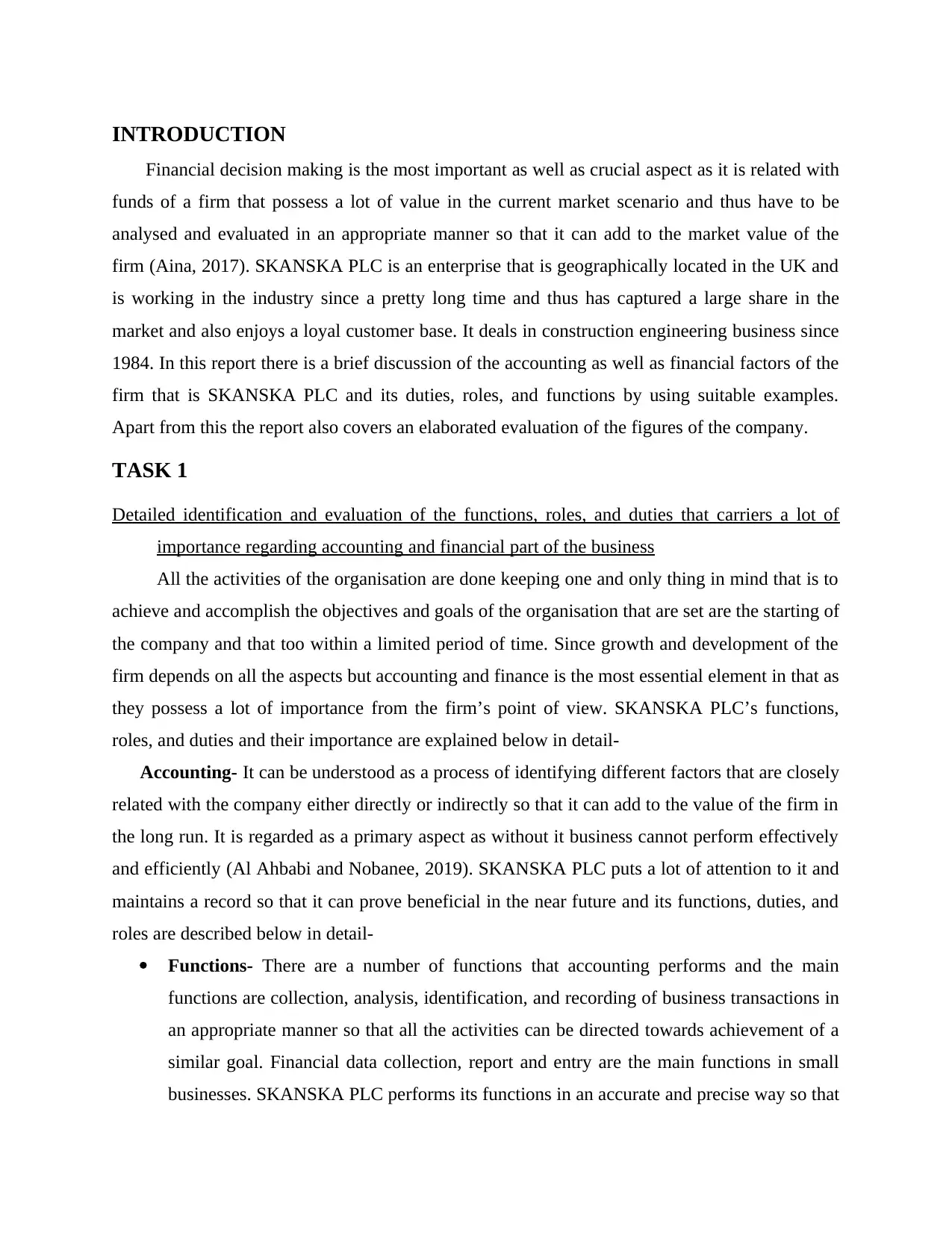
INTRODUCTION
Financial decision making is the most important as well as crucial aspect as it is related with
funds of a firm that possess a lot of value in the current market scenario and thus have to be
analysed and evaluated in an appropriate manner so that it can add to the market value of the
firm (Aina, 2017). SKANSKA PLC is an enterprise that is geographically located in the UK and
is working in the industry since a pretty long time and thus has captured a large share in the
market and also enjoys a loyal customer base. It deals in construction engineering business since
1984. In this report there is a brief discussion of the accounting as well as financial factors of the
firm that is SKANSKA PLC and its duties, roles, and functions by using suitable examples.
Apart from this the report also covers an elaborated evaluation of the figures of the company.
TASK 1
Detailed identification and evaluation of the functions, roles, and duties that carriers a lot of
importance regarding accounting and financial part of the business
All the activities of the organisation are done keeping one and only thing in mind that is to
achieve and accomplish the objectives and goals of the organisation that are set are the starting of
the company and that too within a limited period of time. Since growth and development of the
firm depends on all the aspects but accounting and finance is the most essential element in that as
they possess a lot of importance from the firm’s point of view. SKANSKA PLC’s functions,
roles, and duties and their importance are explained below in detail-
Accounting- It can be understood as a process of identifying different factors that are closely
related with the company either directly or indirectly so that it can add to the value of the firm in
the long run. It is regarded as a primary aspect as without it business cannot perform effectively
and efficiently (Al Ahbabi and Nobanee, 2019). SKANSKA PLC puts a lot of attention to it and
maintains a record so that it can prove beneficial in the near future and its functions, duties, and
roles are described below in detail-
Functions- There are a number of functions that accounting performs and the main
functions are collection, analysis, identification, and recording of business transactions in
an appropriate manner so that all the activities can be directed towards achievement of a
similar goal. Financial data collection, report and entry are the main functions in small
businesses. SKANSKA PLC performs its functions in an accurate and precise way so that
Financial decision making is the most important as well as crucial aspect as it is related with
funds of a firm that possess a lot of value in the current market scenario and thus have to be
analysed and evaluated in an appropriate manner so that it can add to the market value of the
firm (Aina, 2017). SKANSKA PLC is an enterprise that is geographically located in the UK and
is working in the industry since a pretty long time and thus has captured a large share in the
market and also enjoys a loyal customer base. It deals in construction engineering business since
1984. In this report there is a brief discussion of the accounting as well as financial factors of the
firm that is SKANSKA PLC and its duties, roles, and functions by using suitable examples.
Apart from this the report also covers an elaborated evaluation of the figures of the company.
TASK 1
Detailed identification and evaluation of the functions, roles, and duties that carriers a lot of
importance regarding accounting and financial part of the business
All the activities of the organisation are done keeping one and only thing in mind that is to
achieve and accomplish the objectives and goals of the organisation that are set are the starting of
the company and that too within a limited period of time. Since growth and development of the
firm depends on all the aspects but accounting and finance is the most essential element in that as
they possess a lot of importance from the firm’s point of view. SKANSKA PLC’s functions,
roles, and duties and their importance are explained below in detail-
Accounting- It can be understood as a process of identifying different factors that are closely
related with the company either directly or indirectly so that it can add to the value of the firm in
the long run. It is regarded as a primary aspect as without it business cannot perform effectively
and efficiently (Al Ahbabi and Nobanee, 2019). SKANSKA PLC puts a lot of attention to it and
maintains a record so that it can prove beneficial in the near future and its functions, duties, and
roles are described below in detail-
Functions- There are a number of functions that accounting performs and the main
functions are collection, analysis, identification, and recording of business transactions in
an appropriate manner so that all the activities can be directed towards achievement of a
similar goal. Financial data collection, report and entry are the main functions in small
businesses. SKANSKA PLC performs its functions in an accurate and precise way so that
⊘ This is a preview!⊘
Do you want full access?
Subscribe today to unlock all pages.

Trusted by 1+ million students worldwide
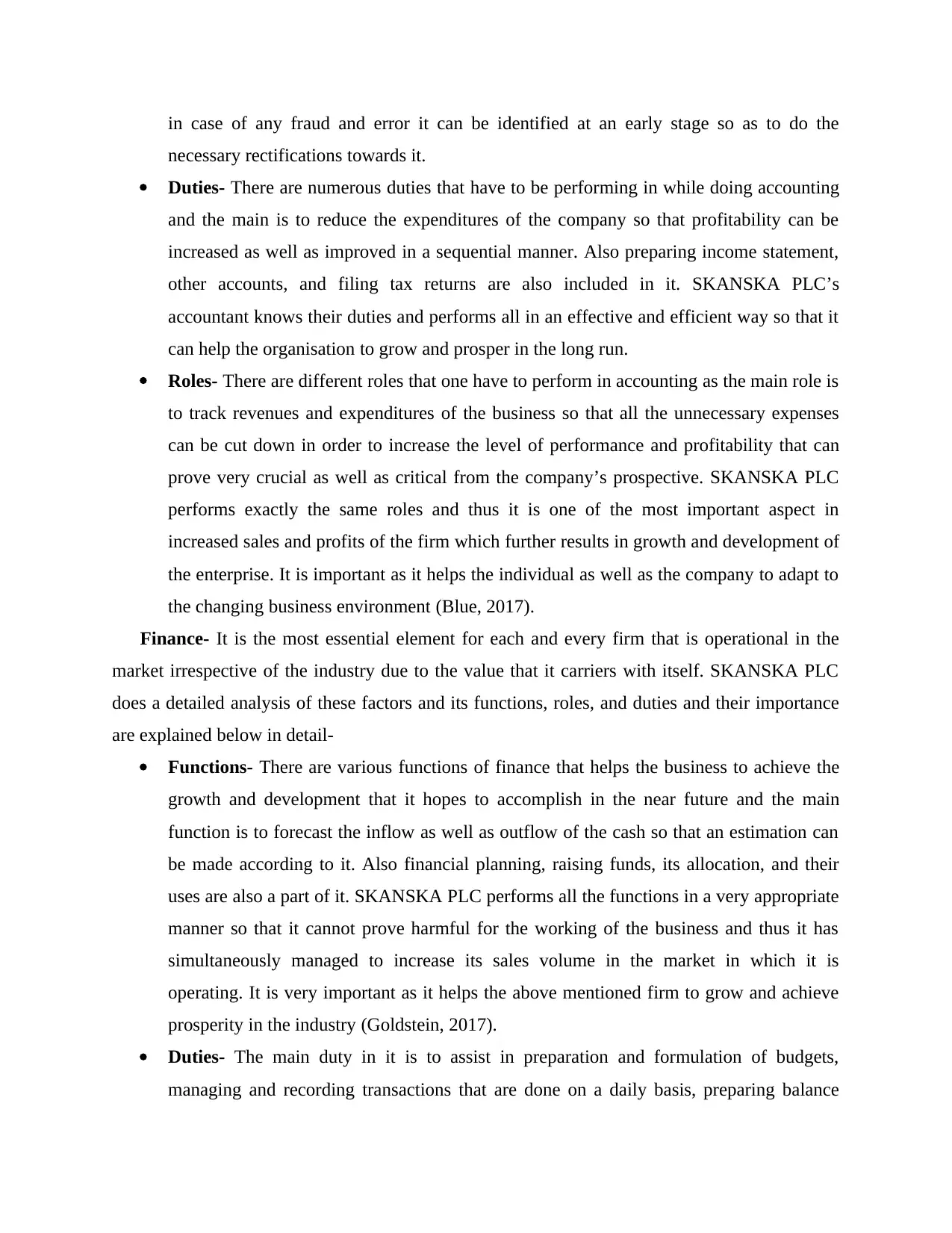
in case of any fraud and error it can be identified at an early stage so as to do the
necessary rectifications towards it.
Duties- There are numerous duties that have to be performing in while doing accounting
and the main is to reduce the expenditures of the company so that profitability can be
increased as well as improved in a sequential manner. Also preparing income statement,
other accounts, and filing tax returns are also included in it. SKANSKA PLC’s
accountant knows their duties and performs all in an effective and efficient way so that it
can help the organisation to grow and prosper in the long run.
Roles- There are different roles that one have to perform in accounting as the main role is
to track revenues and expenditures of the business so that all the unnecessary expenses
can be cut down in order to increase the level of performance and profitability that can
prove very crucial as well as critical from the company’s prospective. SKANSKA PLC
performs exactly the same roles and thus it is one of the most important aspect in
increased sales and profits of the firm which further results in growth and development of
the enterprise. It is important as it helps the individual as well as the company to adapt to
the changing business environment (Blue, 2017).
Finance- It is the most essential element for each and every firm that is operational in the
market irrespective of the industry due to the value that it carriers with itself. SKANSKA PLC
does a detailed analysis of these factors and its functions, roles, and duties and their importance
are explained below in detail-
Functions- There are various functions of finance that helps the business to achieve the
growth and development that it hopes to accomplish in the near future and the main
function is to forecast the inflow as well as outflow of the cash so that an estimation can
be made according to it. Also financial planning, raising funds, its allocation, and their
uses are also a part of it. SKANSKA PLC performs all the functions in a very appropriate
manner so that it cannot prove harmful for the working of the business and thus it has
simultaneously managed to increase its sales volume in the market in which it is
operating. It is very important as it helps the above mentioned firm to grow and achieve
prosperity in the industry (Goldstein, 2017).
Duties- The main duty in it is to assist in preparation and formulation of budgets,
managing and recording transactions that are done on a daily basis, preparing balance
necessary rectifications towards it.
Duties- There are numerous duties that have to be performing in while doing accounting
and the main is to reduce the expenditures of the company so that profitability can be
increased as well as improved in a sequential manner. Also preparing income statement,
other accounts, and filing tax returns are also included in it. SKANSKA PLC’s
accountant knows their duties and performs all in an effective and efficient way so that it
can help the organisation to grow and prosper in the long run.
Roles- There are different roles that one have to perform in accounting as the main role is
to track revenues and expenditures of the business so that all the unnecessary expenses
can be cut down in order to increase the level of performance and profitability that can
prove very crucial as well as critical from the company’s prospective. SKANSKA PLC
performs exactly the same roles and thus it is one of the most important aspect in
increased sales and profits of the firm which further results in growth and development of
the enterprise. It is important as it helps the individual as well as the company to adapt to
the changing business environment (Blue, 2017).
Finance- It is the most essential element for each and every firm that is operational in the
market irrespective of the industry due to the value that it carriers with itself. SKANSKA PLC
does a detailed analysis of these factors and its functions, roles, and duties and their importance
are explained below in detail-
Functions- There are various functions of finance that helps the business to achieve the
growth and development that it hopes to accomplish in the near future and the main
function is to forecast the inflow as well as outflow of the cash so that an estimation can
be made according to it. Also financial planning, raising funds, its allocation, and their
uses are also a part of it. SKANSKA PLC performs all the functions in a very appropriate
manner so that it cannot prove harmful for the working of the business and thus it has
simultaneously managed to increase its sales volume in the market in which it is
operating. It is very important as it helps the above mentioned firm to grow and achieve
prosperity in the industry (Goldstein, 2017).
Duties- The main duty in it is to assist in preparation and formulation of budgets,
managing and recording transactions that are done on a daily basis, preparing balance
Paraphrase This Document
Need a fresh take? Get an instant paraphrase of this document with our AI Paraphraser
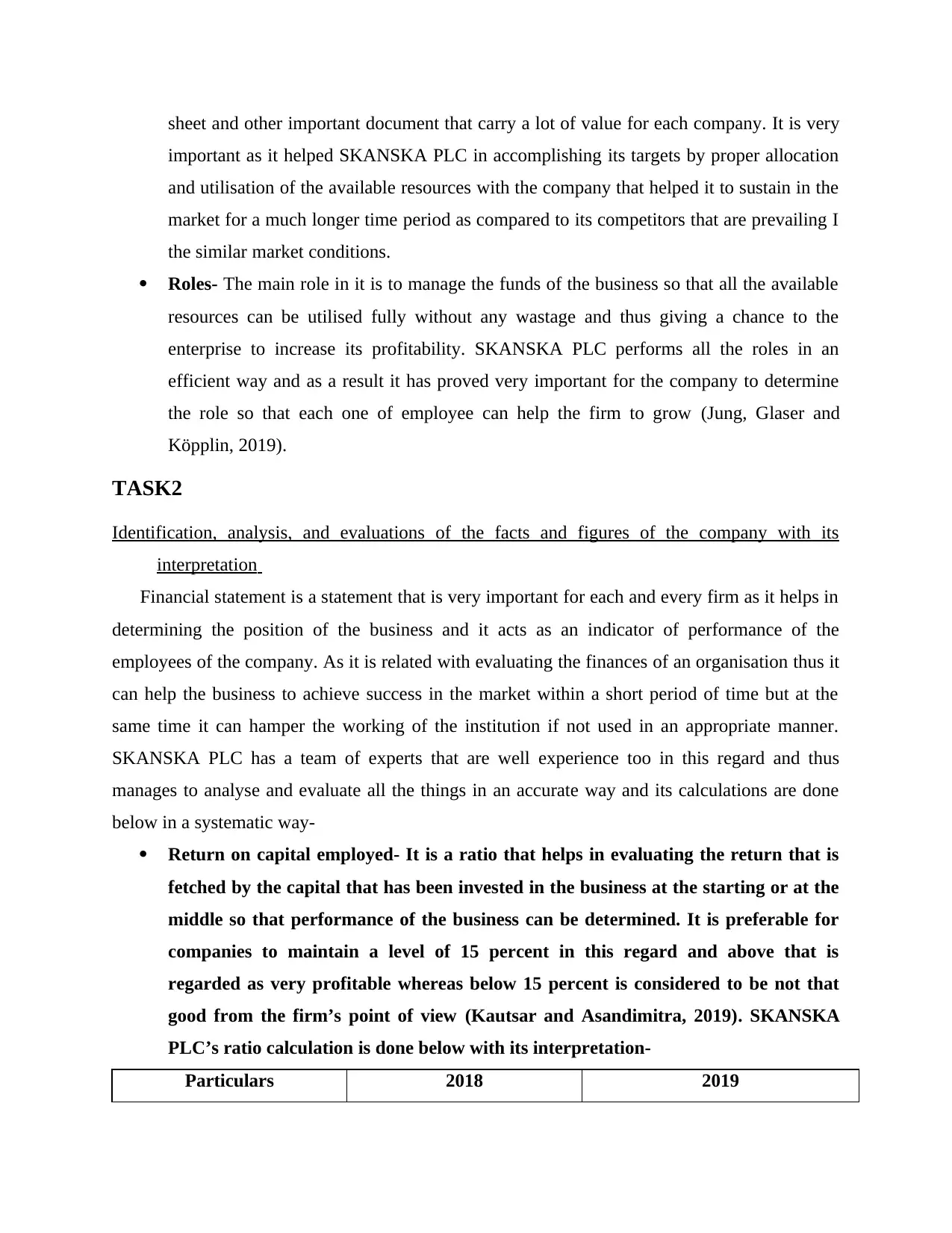
sheet and other important document that carry a lot of value for each company. It is very
important as it helped SKANSKA PLC in accomplishing its targets by proper allocation
and utilisation of the available resources with the company that helped it to sustain in the
market for a much longer time period as compared to its competitors that are prevailing I
the similar market conditions.
Roles- The main role in it is to manage the funds of the business so that all the available
resources can be utilised fully without any wastage and thus giving a chance to the
enterprise to increase its profitability. SKANSKA PLC performs all the roles in an
efficient way and as a result it has proved very important for the company to determine
the role so that each one of employee can help the firm to grow (Jung, Glaser and
Köpplin, 2019).
TASK2
Identification, analysis, and evaluations of the facts and figures of the company with its
interpretation
Financial statement is a statement that is very important for each and every firm as it helps in
determining the position of the business and it acts as an indicator of performance of the
employees of the company. As it is related with evaluating the finances of an organisation thus it
can help the business to achieve success in the market within a short period of time but at the
same time it can hamper the working of the institution if not used in an appropriate manner.
SKANSKA PLC has a team of experts that are well experience too in this regard and thus
manages to analyse and evaluate all the things in an accurate way and its calculations are done
below in a systematic way-
Return on capital employed- It is a ratio that helps in evaluating the return that is
fetched by the capital that has been invested in the business at the starting or at the
middle so that performance of the business can be determined. It is preferable for
companies to maintain a level of 15 percent in this regard and above that is
regarded as very profitable whereas below 15 percent is considered to be not that
good from the firm’s point of view (Kautsar and Asandimitra, 2019). SKANSKA
PLC’s ratio calculation is done below with its interpretation-
Particulars 2018 2019
important as it helped SKANSKA PLC in accomplishing its targets by proper allocation
and utilisation of the available resources with the company that helped it to sustain in the
market for a much longer time period as compared to its competitors that are prevailing I
the similar market conditions.
Roles- The main role in it is to manage the funds of the business so that all the available
resources can be utilised fully without any wastage and thus giving a chance to the
enterprise to increase its profitability. SKANSKA PLC performs all the roles in an
efficient way and as a result it has proved very important for the company to determine
the role so that each one of employee can help the firm to grow (Jung, Glaser and
Köpplin, 2019).
TASK2
Identification, analysis, and evaluations of the facts and figures of the company with its
interpretation
Financial statement is a statement that is very important for each and every firm as it helps in
determining the position of the business and it acts as an indicator of performance of the
employees of the company. As it is related with evaluating the finances of an organisation thus it
can help the business to achieve success in the market within a short period of time but at the
same time it can hamper the working of the institution if not used in an appropriate manner.
SKANSKA PLC has a team of experts that are well experience too in this regard and thus
manages to analyse and evaluate all the things in an accurate way and its calculations are done
below in a systematic way-
Return on capital employed- It is a ratio that helps in evaluating the return that is
fetched by the capital that has been invested in the business at the starting or at the
middle so that performance of the business can be determined. It is preferable for
companies to maintain a level of 15 percent in this regard and above that is
regarded as very profitable whereas below 15 percent is considered to be not that
good from the firm’s point of view (Kautsar and Asandimitra, 2019). SKANSKA
PLC’s ratio calculation is done below with its interpretation-
Particulars 2018 2019
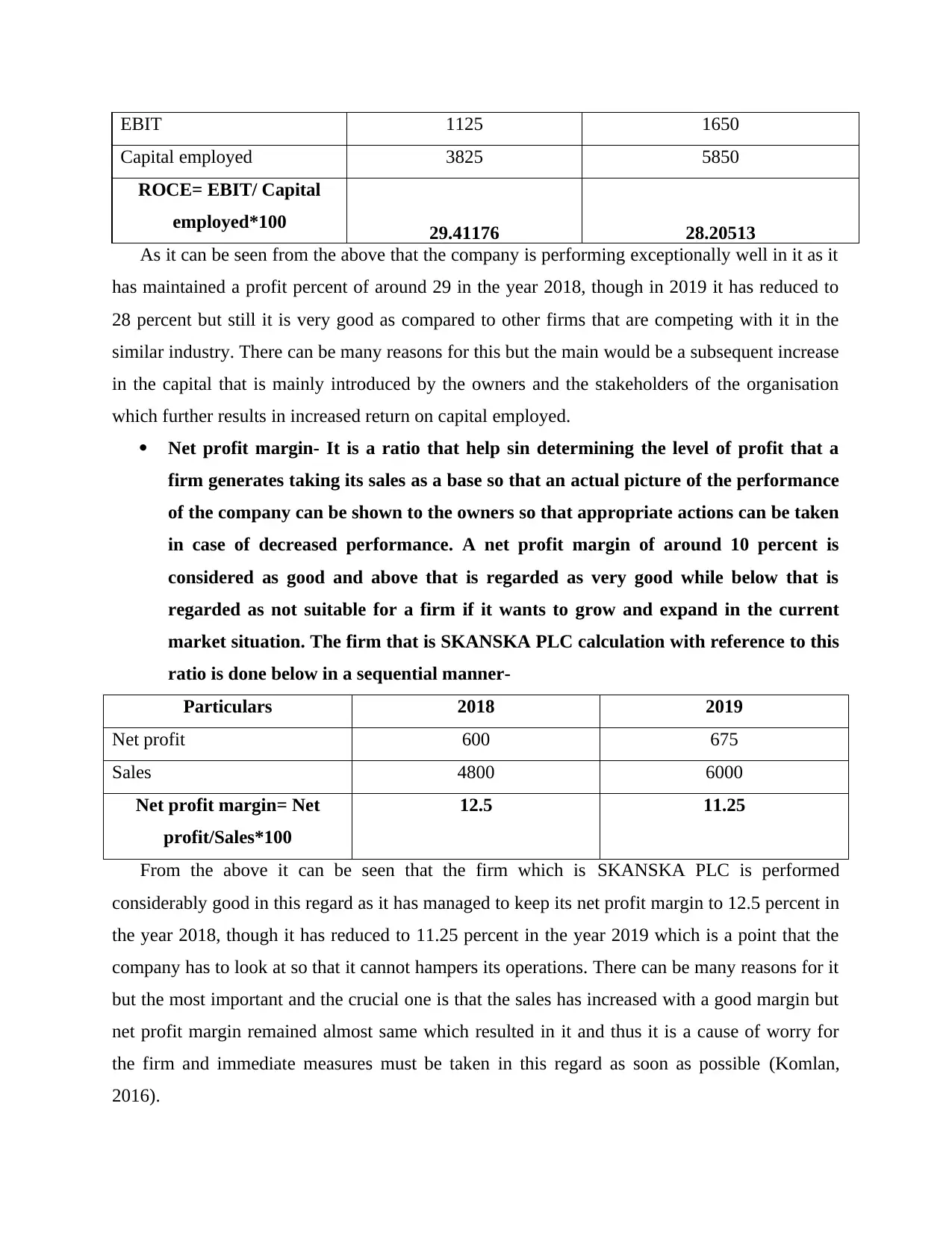
EBIT 1125 1650
Capital employed 3825 5850
ROCE= EBIT/ Capital
employed*100 29.41176 28.20513
As it can be seen from the above that the company is performing exceptionally well in it as it
has maintained a profit percent of around 29 in the year 2018, though in 2019 it has reduced to
28 percent but still it is very good as compared to other firms that are competing with it in the
similar industry. There can be many reasons for this but the main would be a subsequent increase
in the capital that is mainly introduced by the owners and the stakeholders of the organisation
which further results in increased return on capital employed.
Net profit margin- It is a ratio that help sin determining the level of profit that a
firm generates taking its sales as a base so that an actual picture of the performance
of the company can be shown to the owners so that appropriate actions can be taken
in case of decreased performance. A net profit margin of around 10 percent is
considered as good and above that is regarded as very good while below that is
regarded as not suitable for a firm if it wants to grow and expand in the current
market situation. The firm that is SKANSKA PLC calculation with reference to this
ratio is done below in a sequential manner-
Particulars 2018 2019
Net profit 600 675
Sales 4800 6000
Net profit margin= Net
profit/Sales*100
12.5 11.25
From the above it can be seen that the firm which is SKANSKA PLC is performed
considerably good in this regard as it has managed to keep its net profit margin to 12.5 percent in
the year 2018, though it has reduced to 11.25 percent in the year 2019 which is a point that the
company has to look at so that it cannot hampers its operations. There can be many reasons for it
but the most important and the crucial one is that the sales has increased with a good margin but
net profit margin remained almost same which resulted in it and thus it is a cause of worry for
the firm and immediate measures must be taken in this regard as soon as possible (Komlan,
2016).
Capital employed 3825 5850
ROCE= EBIT/ Capital
employed*100 29.41176 28.20513
As it can be seen from the above that the company is performing exceptionally well in it as it
has maintained a profit percent of around 29 in the year 2018, though in 2019 it has reduced to
28 percent but still it is very good as compared to other firms that are competing with it in the
similar industry. There can be many reasons for this but the main would be a subsequent increase
in the capital that is mainly introduced by the owners and the stakeholders of the organisation
which further results in increased return on capital employed.
Net profit margin- It is a ratio that help sin determining the level of profit that a
firm generates taking its sales as a base so that an actual picture of the performance
of the company can be shown to the owners so that appropriate actions can be taken
in case of decreased performance. A net profit margin of around 10 percent is
considered as good and above that is regarded as very good while below that is
regarded as not suitable for a firm if it wants to grow and expand in the current
market situation. The firm that is SKANSKA PLC calculation with reference to this
ratio is done below in a sequential manner-
Particulars 2018 2019
Net profit 600 675
Sales 4800 6000
Net profit margin= Net
profit/Sales*100
12.5 11.25
From the above it can be seen that the firm which is SKANSKA PLC is performed
considerably good in this regard as it has managed to keep its net profit margin to 12.5 percent in
the year 2018, though it has reduced to 11.25 percent in the year 2019 which is a point that the
company has to look at so that it cannot hampers its operations. There can be many reasons for it
but the most important and the crucial one is that the sales has increased with a good margin but
net profit margin remained almost same which resulted in it and thus it is a cause of worry for
the firm and immediate measures must be taken in this regard as soon as possible (Komlan,
2016).
⊘ This is a preview!⊘
Do you want full access?
Subscribe today to unlock all pages.

Trusted by 1+ million students worldwide
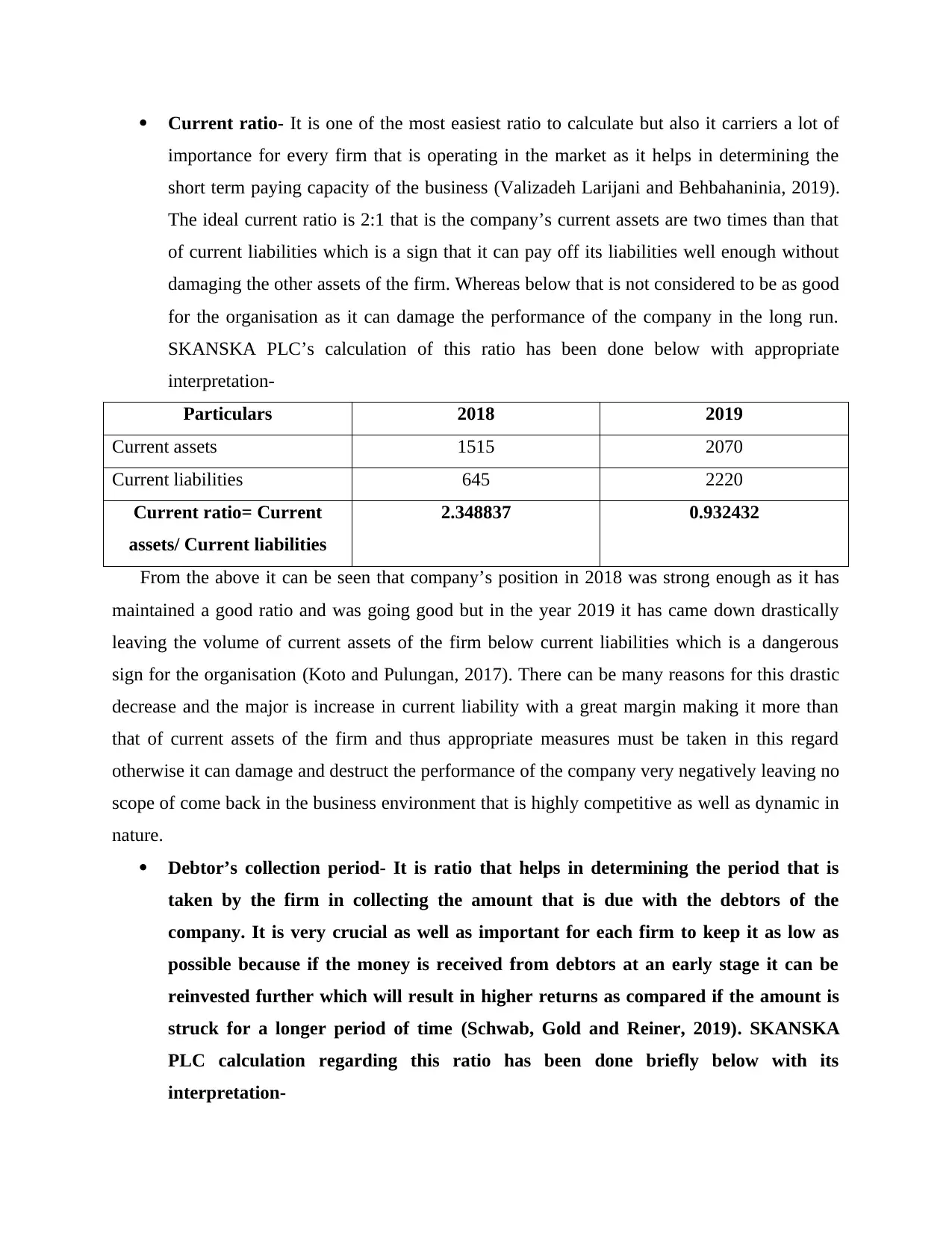
Current ratio- It is one of the most easiest ratio to calculate but also it carriers a lot of
importance for every firm that is operating in the market as it helps in determining the
short term paying capacity of the business (Valizadeh Larijani and Behbahaninia, 2019).
The ideal current ratio is 2:1 that is the company’s current assets are two times than that
of current liabilities which is a sign that it can pay off its liabilities well enough without
damaging the other assets of the firm. Whereas below that is not considered to be as good
for the organisation as it can damage the performance of the company in the long run.
SKANSKA PLC’s calculation of this ratio has been done below with appropriate
interpretation-
Particulars 2018 2019
Current assets 1515 2070
Current liabilities 645 2220
Current ratio= Current
assets/ Current liabilities
2.348837 0.932432
From the above it can be seen that company’s position in 2018 was strong enough as it has
maintained a good ratio and was going good but in the year 2019 it has came down drastically
leaving the volume of current assets of the firm below current liabilities which is a dangerous
sign for the organisation (Koto and Pulungan, 2017). There can be many reasons for this drastic
decrease and the major is increase in current liability with a great margin making it more than
that of current assets of the firm and thus appropriate measures must be taken in this regard
otherwise it can damage and destruct the performance of the company very negatively leaving no
scope of come back in the business environment that is highly competitive as well as dynamic in
nature.
Debtor’s collection period- It is ratio that helps in determining the period that is
taken by the firm in collecting the amount that is due with the debtors of the
company. It is very crucial as well as important for each firm to keep it as low as
possible because if the money is received from debtors at an early stage it can be
reinvested further which will result in higher returns as compared if the amount is
struck for a longer period of time (Schwab, Gold and Reiner, 2019). SKANSKA
PLC calculation regarding this ratio has been done briefly below with its
interpretation-
importance for every firm that is operating in the market as it helps in determining the
short term paying capacity of the business (Valizadeh Larijani and Behbahaninia, 2019).
The ideal current ratio is 2:1 that is the company’s current assets are two times than that
of current liabilities which is a sign that it can pay off its liabilities well enough without
damaging the other assets of the firm. Whereas below that is not considered to be as good
for the organisation as it can damage the performance of the company in the long run.
SKANSKA PLC’s calculation of this ratio has been done below with appropriate
interpretation-
Particulars 2018 2019
Current assets 1515 2070
Current liabilities 645 2220
Current ratio= Current
assets/ Current liabilities
2.348837 0.932432
From the above it can be seen that company’s position in 2018 was strong enough as it has
maintained a good ratio and was going good but in the year 2019 it has came down drastically
leaving the volume of current assets of the firm below current liabilities which is a dangerous
sign for the organisation (Koto and Pulungan, 2017). There can be many reasons for this drastic
decrease and the major is increase in current liability with a great margin making it more than
that of current assets of the firm and thus appropriate measures must be taken in this regard
otherwise it can damage and destruct the performance of the company very negatively leaving no
scope of come back in the business environment that is highly competitive as well as dynamic in
nature.
Debtor’s collection period- It is ratio that helps in determining the period that is
taken by the firm in collecting the amount that is due with the debtors of the
company. It is very crucial as well as important for each firm to keep it as low as
possible because if the money is received from debtors at an early stage it can be
reinvested further which will result in higher returns as compared if the amount is
struck for a longer period of time (Schwab, Gold and Reiner, 2019). SKANSKA
PLC calculation regarding this ratio has been done briefly below with its
interpretation-
Paraphrase This Document
Need a fresh take? Get an instant paraphrase of this document with our AI Paraphraser
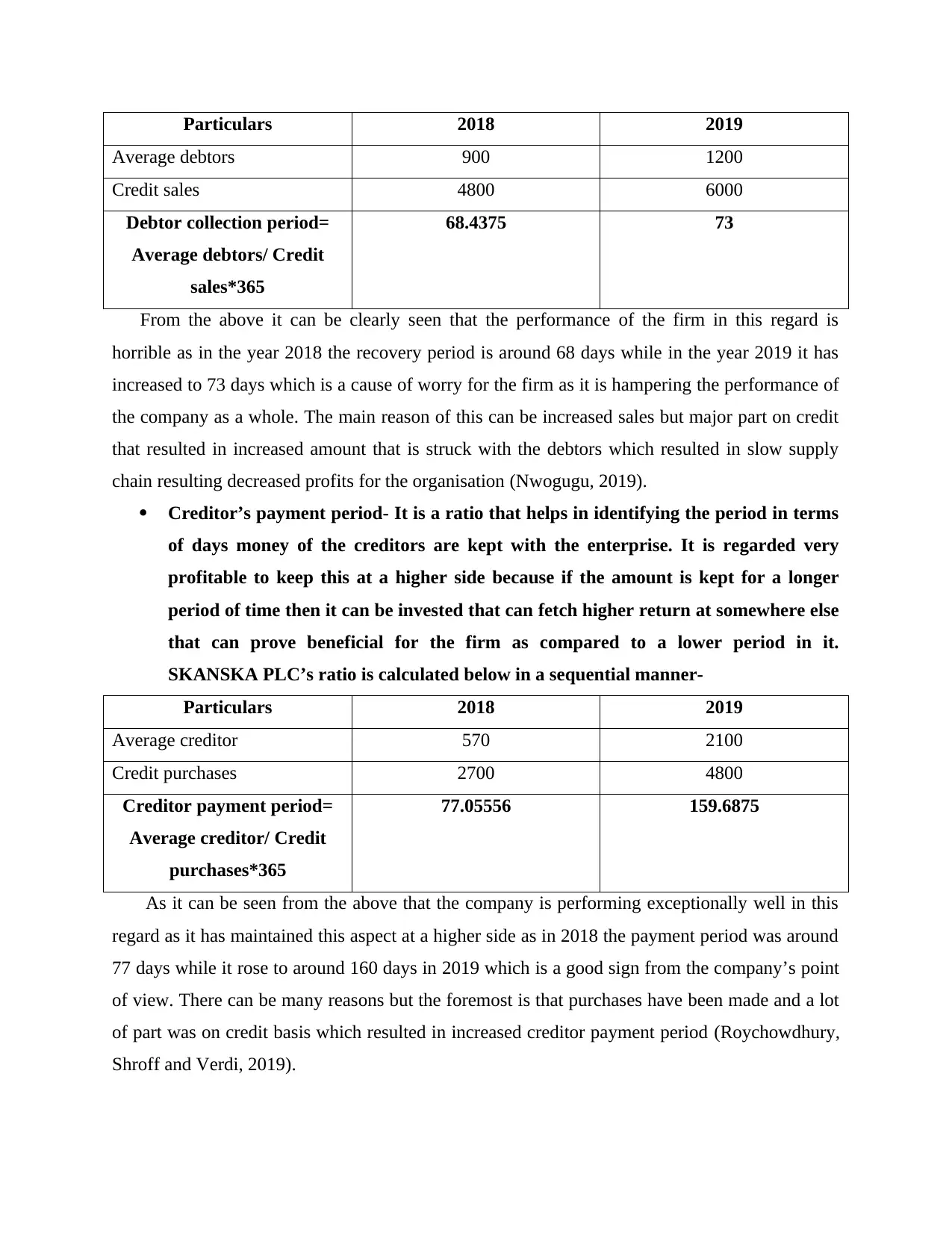
Particulars 2018 2019
Average debtors 900 1200
Credit sales 4800 6000
Debtor collection period=
Average debtors/ Credit
sales*365
68.4375 73
From the above it can be clearly seen that the performance of the firm in this regard is
horrible as in the year 2018 the recovery period is around 68 days while in the year 2019 it has
increased to 73 days which is a cause of worry for the firm as it is hampering the performance of
the company as a whole. The main reason of this can be increased sales but major part on credit
that resulted in increased amount that is struck with the debtors which resulted in slow supply
chain resulting decreased profits for the organisation (Nwogugu, 2019).
Creditor’s payment period- It is a ratio that helps in identifying the period in terms
of days money of the creditors are kept with the enterprise. It is regarded very
profitable to keep this at a higher side because if the amount is kept for a longer
period of time then it can be invested that can fetch higher return at somewhere else
that can prove beneficial for the firm as compared to a lower period in it.
SKANSKA PLC’s ratio is calculated below in a sequential manner-
Particulars 2018 2019
Average creditor 570 2100
Credit purchases 2700 4800
Creditor payment period=
Average creditor/ Credit
purchases*365
77.05556 159.6875
As it can be seen from the above that the company is performing exceptionally well in this
regard as it has maintained this aspect at a higher side as in 2018 the payment period was around
77 days while it rose to around 160 days in 2019 which is a good sign from the company’s point
of view. There can be many reasons but the foremost is that purchases have been made and a lot
of part was on credit basis which resulted in increased creditor payment period (Roychowdhury,
Shroff and Verdi, 2019).
Average debtors 900 1200
Credit sales 4800 6000
Debtor collection period=
Average debtors/ Credit
sales*365
68.4375 73
From the above it can be clearly seen that the performance of the firm in this regard is
horrible as in the year 2018 the recovery period is around 68 days while in the year 2019 it has
increased to 73 days which is a cause of worry for the firm as it is hampering the performance of
the company as a whole. The main reason of this can be increased sales but major part on credit
that resulted in increased amount that is struck with the debtors which resulted in slow supply
chain resulting decreased profits for the organisation (Nwogugu, 2019).
Creditor’s payment period- It is a ratio that helps in identifying the period in terms
of days money of the creditors are kept with the enterprise. It is regarded very
profitable to keep this at a higher side because if the amount is kept for a longer
period of time then it can be invested that can fetch higher return at somewhere else
that can prove beneficial for the firm as compared to a lower period in it.
SKANSKA PLC’s ratio is calculated below in a sequential manner-
Particulars 2018 2019
Average creditor 570 2100
Credit purchases 2700 4800
Creditor payment period=
Average creditor/ Credit
purchases*365
77.05556 159.6875
As it can be seen from the above that the company is performing exceptionally well in this
regard as it has maintained this aspect at a higher side as in 2018 the payment period was around
77 days while it rose to around 160 days in 2019 which is a good sign from the company’s point
of view. There can be many reasons but the foremost is that purchases have been made and a lot
of part was on credit basis which resulted in increased creditor payment period (Roychowdhury,
Shroff and Verdi, 2019).
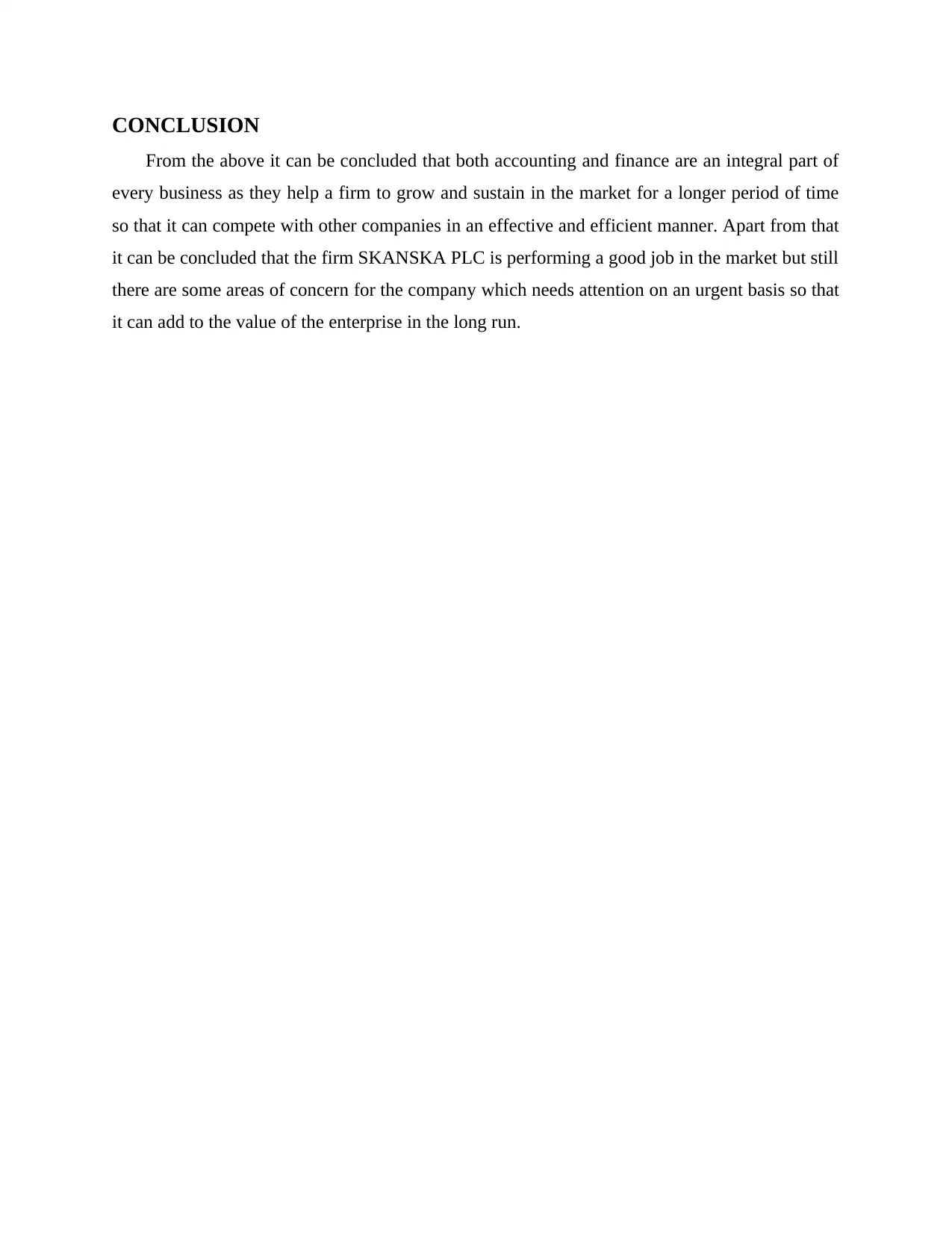
CONCLUSION
From the above it can be concluded that both accounting and finance are an integral part of
every business as they help a firm to grow and sustain in the market for a longer period of time
so that it can compete with other companies in an effective and efficient manner. Apart from that
it can be concluded that the firm SKANSKA PLC is performing a good job in the market but still
there are some areas of concern for the company which needs attention on an urgent basis so that
it can add to the value of the enterprise in the long run.
From the above it can be concluded that both accounting and finance are an integral part of
every business as they help a firm to grow and sustain in the market for a longer period of time
so that it can compete with other companies in an effective and efficient manner. Apart from that
it can be concluded that the firm SKANSKA PLC is performing a good job in the market but still
there are some areas of concern for the company which needs attention on an urgent basis so that
it can add to the value of the enterprise in the long run.
⊘ This is a preview!⊘
Do you want full access?
Subscribe today to unlock all pages.

Trusted by 1+ million students worldwide
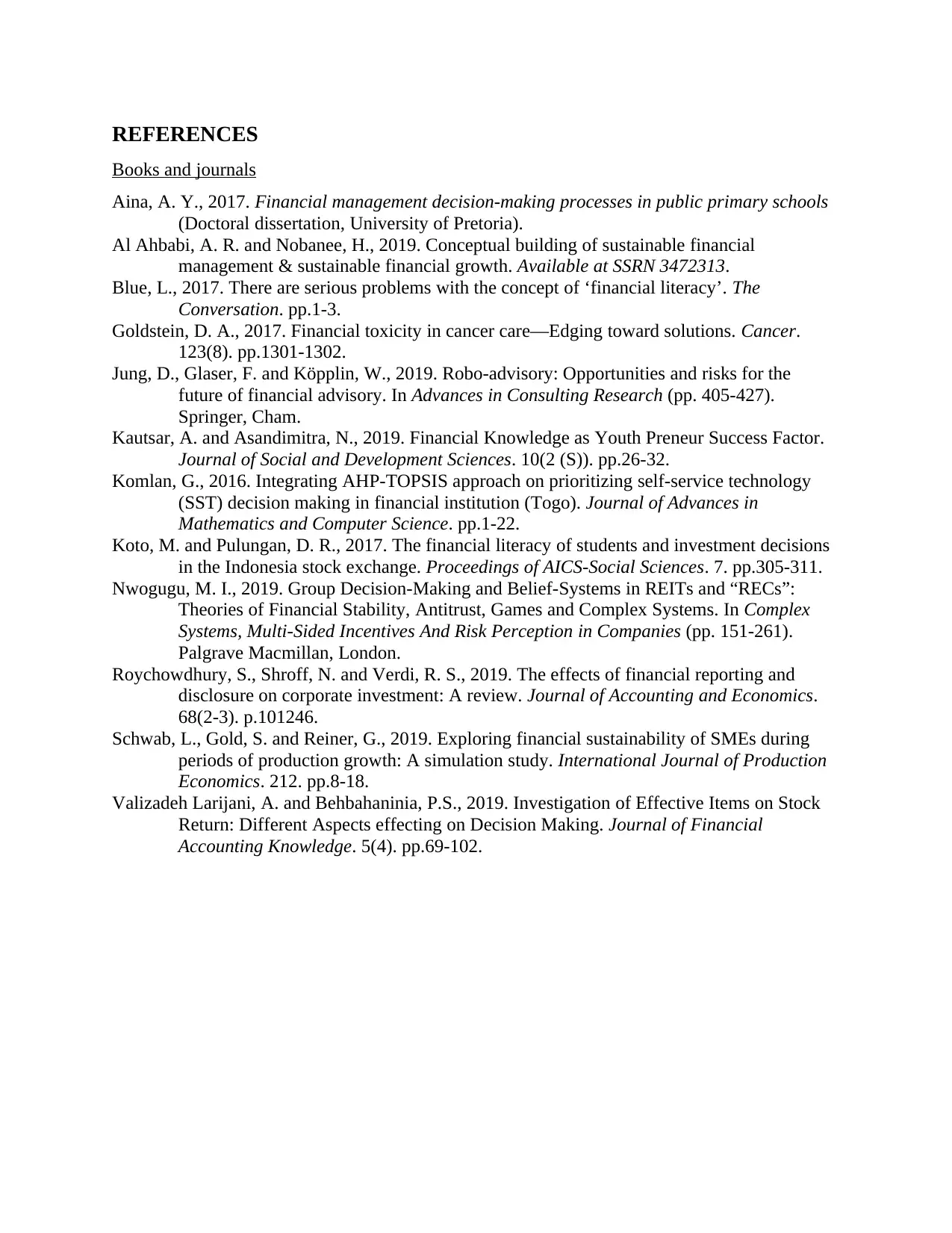
REFERENCES
Books and journals
Aina, A. Y., 2017. Financial management decision-making processes in public primary schools
(Doctoral dissertation, University of Pretoria).
Al Ahbabi, A. R. and Nobanee, H., 2019. Conceptual building of sustainable financial
management & sustainable financial growth. Available at SSRN 3472313.
Blue, L., 2017. There are serious problems with the concept of ‘financial literacy’. The
Conversation. pp.1-3.
Goldstein, D. A., 2017. Financial toxicity in cancer care—Edging toward solutions. Cancer.
123(8). pp.1301-1302.
Jung, D., Glaser, F. and Köpplin, W., 2019. Robo-advisory: Opportunities and risks for the
future of financial advisory. In Advances in Consulting Research (pp. 405-427).
Springer, Cham.
Kautsar, A. and Asandimitra, N., 2019. Financial Knowledge as Youth Preneur Success Factor.
Journal of Social and Development Sciences. 10(2 (S)). pp.26-32.
Komlan, G., 2016. Integrating AHP-TOPSIS approach on prioritizing self-service technology
(SST) decision making in financial institution (Togo). Journal of Advances in
Mathematics and Computer Science. pp.1-22.
Koto, M. and Pulungan, D. R., 2017. The financial literacy of students and investment decisions
in the Indonesia stock exchange. Proceedings of AICS-Social Sciences. 7. pp.305-311.
Nwogugu, M. I., 2019. Group Decision-Making and Belief-Systems in REITs and “RECs”:
Theories of Financial Stability, Antitrust, Games and Complex Systems. In Complex
Systems, Multi-Sided Incentives And Risk Perception in Companies (pp. 151-261).
Palgrave Macmillan, London.
Roychowdhury, S., Shroff, N. and Verdi, R. S., 2019. The effects of financial reporting and
disclosure on corporate investment: A review. Journal of Accounting and Economics.
68(2-3). p.101246.
Schwab, L., Gold, S. and Reiner, G., 2019. Exploring financial sustainability of SMEs during
periods of production growth: A simulation study. International Journal of Production
Economics. 212. pp.8-18.
Valizadeh Larijani, A. and Behbahaninia, P.S., 2019. Investigation of Effective Items on Stock
Return: Different Aspects effecting on Decision Making. Journal of Financial
Accounting Knowledge. 5(4). pp.69-102.
Books and journals
Aina, A. Y., 2017. Financial management decision-making processes in public primary schools
(Doctoral dissertation, University of Pretoria).
Al Ahbabi, A. R. and Nobanee, H., 2019. Conceptual building of sustainable financial
management & sustainable financial growth. Available at SSRN 3472313.
Blue, L., 2017. There are serious problems with the concept of ‘financial literacy’. The
Conversation. pp.1-3.
Goldstein, D. A., 2017. Financial toxicity in cancer care—Edging toward solutions. Cancer.
123(8). pp.1301-1302.
Jung, D., Glaser, F. and Köpplin, W., 2019. Robo-advisory: Opportunities and risks for the
future of financial advisory. In Advances in Consulting Research (pp. 405-427).
Springer, Cham.
Kautsar, A. and Asandimitra, N., 2019. Financial Knowledge as Youth Preneur Success Factor.
Journal of Social and Development Sciences. 10(2 (S)). pp.26-32.
Komlan, G., 2016. Integrating AHP-TOPSIS approach on prioritizing self-service technology
(SST) decision making in financial institution (Togo). Journal of Advances in
Mathematics and Computer Science. pp.1-22.
Koto, M. and Pulungan, D. R., 2017. The financial literacy of students and investment decisions
in the Indonesia stock exchange. Proceedings of AICS-Social Sciences. 7. pp.305-311.
Nwogugu, M. I., 2019. Group Decision-Making and Belief-Systems in REITs and “RECs”:
Theories of Financial Stability, Antitrust, Games and Complex Systems. In Complex
Systems, Multi-Sided Incentives And Risk Perception in Companies (pp. 151-261).
Palgrave Macmillan, London.
Roychowdhury, S., Shroff, N. and Verdi, R. S., 2019. The effects of financial reporting and
disclosure on corporate investment: A review. Journal of Accounting and Economics.
68(2-3). p.101246.
Schwab, L., Gold, S. and Reiner, G., 2019. Exploring financial sustainability of SMEs during
periods of production growth: A simulation study. International Journal of Production
Economics. 212. pp.8-18.
Valizadeh Larijani, A. and Behbahaninia, P.S., 2019. Investigation of Effective Items on Stock
Return: Different Aspects effecting on Decision Making. Journal of Financial
Accounting Knowledge. 5(4). pp.69-102.
1 out of 10
Related Documents
Your All-in-One AI-Powered Toolkit for Academic Success.
+13062052269
info@desklib.com
Available 24*7 on WhatsApp / Email
![[object Object]](/_next/static/media/star-bottom.7253800d.svg)
Unlock your academic potential
Copyright © 2020–2025 A2Z Services. All Rights Reserved. Developed and managed by ZUCOL.




